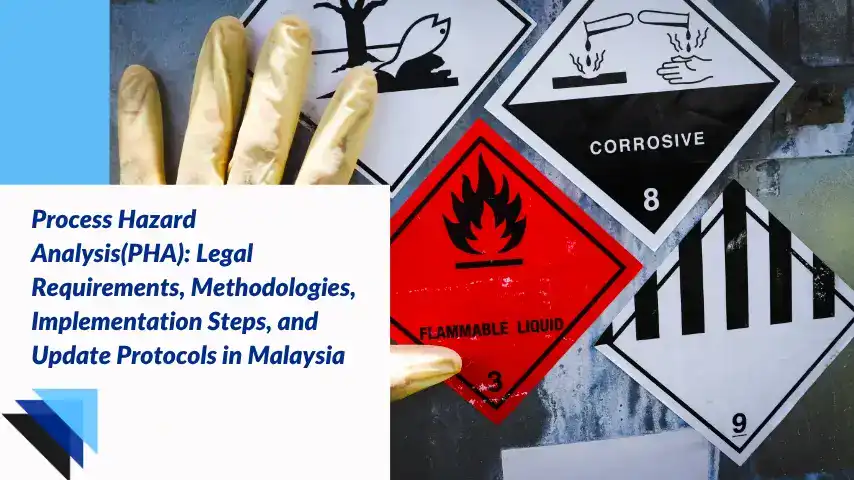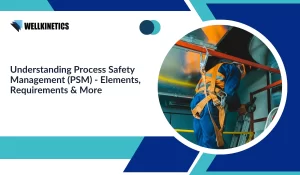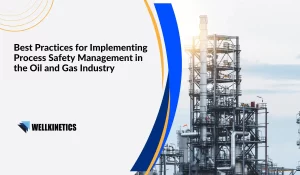Process Hazard Analysis (PHA) is a systematic and comprehensive evaluation methodology required by Malaysian regulations to identify and assess potential hazards in industrial processes.
Are you struggling to navigate the complex landscape of PHA requirements in Malaysia? You’re not alone. Many industry professionals find themselves overwhelmed by the intricate legal frameworks and implementation protocols.
In this comprehensive guide, we’ll break down everything you need to know about PHA in Malaysia:
- Legal requirements and regulatory compliance standards
- Step-by-step implementation guide
- Essential update protocols and documentation requirements
- Best practices for conducting effective hazard assessments
Whether you’re a safety manager, process engineer, or facility operator, this guide will equip you with practical insights to ensure your PHA process aligns with Malaysian regulations while effectively safeguarding your operations.
Is your PHA methodology aligned with your unique business needs and regulatory requirements?
We work with you to customize a PHA approach that fits your organization’s specific risks, ensuring compliance with Malaysian standards.
- What Are the Legal Requirements for Conducting a Process Hazard Analysis in Malaysia?
- What Are the Essential Methodologies Used in Process Hazard Analysis (PHA)?
- How Can Organizations Implement a Process Hazard Analysis Step by Step?
- Why Are Update and Review Protocols Important for Process Hazard Analysis?
- What Are the Best Practices for Conducting Effective Hazard Assessments in Malaysia?
- How Wellkinetics Can Help
What Are the Legal Requirements for Conducting a Process Hazard Analysis in Malaysia?
Legal requirements for conducting a Process Hazard Analysis in Malaysia are governed by various regulations aimed at ensuring the safety of industrial operations and the well-being of workers and the environment.
What Is the Regulatory Framework for Process Hazard Analysis in Malaysia?
In Malaysia, the primary regulatory body overseeing industrial safety is the Department of Occupational Safety and Health (DOSH), which enforces several key regulations, including:
- Occupational Safety and Health Act 1994 (OSHA): This act lays the foundation for workplace safety and health, mandating that employers take necessary measures to prevent workplace hazards, including those identified through PHA.
- Chemical Industrial Safety Regulations: Specific regulations apply to the management of chemicals and hazardous processes, requiring thorough assessments to mitigate risks associated with chemical exposure and reaction hazards.
- Environmental Quality Act 1974 (EQA): This legislation focuses on the environmental impact of industrial processes, necessitating that PHA practices should also account for potential environmental hazards and incorporate strategies for pollution prevention and control.
What Are the Key Legal Obligations for Conducting Process Hazard Analysis in Malaysia?
Under Malaysian laws, the following obligations must be adhered to when conducting a PHA:
1. Thorough Documentation: All findings from the PHA must be meticulously documented, including hazard identification, risk assessments, and the measures taken to mitigate those risks. This documentation serves as a record for regulatory compliance and future reference.
2. Regular Review and Updating: Organizations are required to routinely review and update their PHA results and associated procedures to reflect any changes in operations, processes, or regulations. This ongoing assessment ensures that the hazard analysis remains relevant and effective in managing risks.
3. Engagement of Qualified Professionals: Engaging a multidisciplinary team of qualified professionals is essential. This team should include individuals with expertise in process safety, engineering, environmental science, and occupational health to ensure a holistic approach to hazard identification and risk assessment.
4. Training and Awareness: Employers must provide adequate training to staff involved in or affected by the processes subject to PHA. This includes educating employees about potential hazards, safe operating procedures, and emergency response protocols. Cultivating a culture of safety awareness is critical in accident prevention and protecting personnel.
5. Incident Reporting and Investigation: Any incidents or near misses must be reported and investigated thoroughly. Lessons learned from these occurrences should be integrated into the PHA process to enhance future hazard assessments and prevention strategies.
6. Compliance with Notification Requirements: Certain incidents or changes in operational procedures that may alter the risk profile of a facility must be reported to the relevant authorities as per regulatory requirements. Adhering to these notification protocols helps maintain transparency and accountability.
How Does Malaysia’s PHA Requirements Compare to International Standards?
Malaysia’s PHA requirements closely align with international standards like OSHA and ISO guidelines. The country follows a comprehensive approach incorporating elements from global best practices while considering local industrial contexts and regulatory frameworks.
What Are the Consequences of Non-Compliance With PHA Requirements in Malaysia?
Non-compliance can result in hefty fines, operational shutdowns, legal actions, and potential license revocation. Companies may also face increased insurance premiums, reputational damage, and in severe cases, criminal charges if accidents occur due to PHA negligence.
Concerned About Compliance with Malaysian Safety Regulations?
Stay compliant effortlessly with our ongoing regulatory support and updates for your hazard analysis protocols.
What Are the Essential Methodologies Used in Process Hazard Analysis (PHA)?
Process Hazard Analysis (PHA) methodologies are systematic approaches used to identify, evaluate, and control potential hazards associated with industrial processes. These methodologies promote safety and risk management by ensuring that all possible risks are examined and addressed.
What Are the Main Qualitative Methods Used in Process Hazard Analysis?
Process hazard analysis methods encompass various qualitative techniques that focus on identifying and evaluating potential hazards through systematic observation and expert judgment. One of the most widely used qualitative approaches is HAZOP analysis, which examines process deviations and their potential consequences. This method involves a structured team review of process flow diagrams and operating procedures to identify possible hazards.
Another essential qualitative method is the What-If Analysis, which uses brainstorming sessions to identify potential hazard scenarios. This technique is particularly useful in the early stages of process design when detailed information might not be available.
Checklist Analysis is also a fundamental qualitative tool that ensures systematic coverage of common hazards and compliance requirements. It provides a structured approach to verify safety measures and identify gaps in existing controls.
What Are the Main Quantitative Methods Used in Process Hazard Analysis?
Quantitative methods in process hazard analysis provide numerical estimates of risk levels and potential consequences. Fault tree analysis stands out as a primary quantitative technique, using probability calculations to determine the likelihood of specific hazardous events. This method breaks down complex scenarios into basic events and uses Boolean logic to calculate overall system reliability.
Event Tree Analysis (ETA) is another crucial quantitative approach that examines the progression of an initiating event through various possible outcomes. It helps in calculating the probability of different consequence scenarios and assists in risk-based decision making.
Risk matrices combine frequency and severity ratings to provide numerical risk rankings, enabling organizations to prioritize hazard mitigation efforts based on quantitative data. These matrices are essential tools for evaluating worst-case scenarios and determining appropriate risk reduction measures.
What Are Hybrid Approaches in Process Hazard Analysis and How Do They Work?
Modern process hazard analysis often combines both qualitative and quantitative methods to provide comprehensive risk assessment. The Bow-tie Analysis is a perfect example of a hybrid approach, integrating fault tree analysis with event tree analysis to visualize potential accident scenarios and their prevention barriers.
Layer of Protection Analysis (LOPA) is another hybrid method that builds upon HAZOP analysis results to evaluate the adequacy of safeguards through semi-quantitative analysis. This approach helps in determining whether existing safety measures are sufficient or if additional protection layers are needed.
Different process hazard analysis methods can be combined strategically to leverage their respective strengths and provide a more robust safety assessment. This integrated approach ensures both detailed hazard identification and quantitative risk evaluation.
Can Small-Scale Industries in Malaysia Use Simplified PHA Methods?
Yes, small-scale industries can use simplified PHA methods like checklist analysis or What-If analysis, provided they meet basic regulatory requirements. However, the chosen method must be appropriate for the process complexity and potential hazards involved. Even simplified methods should consider human factors and address major accident hazards to ensure comprehensive safety coverage.
RELATED: Understanding Process Hazards and How to Effectively Address Them
How Can Organizations Implement a Process Hazard Analysis Step by Step?
To effectively carry out a Process Hazard Analysis (PHA), organizations can follow a structured implementation guide that outlines each critical step in the process. This ensures a systematic approach to hazard identification and risk assessment.
What Is Involved in Team Formation and Planning for a Process Hazard Analysis?
The first step in implementing Process Hazard Analysis involves assembling a multidisciplinary team of experts. This team should include process engineers, safety specialists, operators, maintenance personnel, and management representatives. Each member brings unique insights and expertise to the analysis process.
The planning phase requires establishing clear objectives, timelines, and resource allocation. The team must develop a comprehensive schedule that accounts for data collection, analysis sessions, and documentation requirements. This ensures a structured approach to the entire PHA process, including consideration of facility siting and process equipment evaluation.
What Does the Hazard Identification Process Involve in Process Hazard Analysis?
Once the team is formed, they conduct a step-by-step review of the operating procedure to identify potential hazards. This involves examining process flow diagrams, piping and instrumentation diagrams, and equipment specifications. The team systematically analyzes each process unit, looking for potential deviations that could lead to safety incidents.
During this phase, the team documents all identified hazards, including their potential causes and consequences. They also review historical incident data and industry best practices to ensure comprehensive hazard identification. This process should include consideration of chemical releases, fires, and explosions as potential hazardous scenarios.
RELATED: HAZOP vs. HAZID: Key Differences, Applications, and When to Use Each in Malaysia
How Is Risk Assessment and Mitigation Conducted in Process Hazard Analysis?
After identifying hazards, the team evaluates the associated risks using predetermined criteria. This includes assessing the likelihood and severity of potential incidents. The team then prioritizes risks based on their significance and develops appropriate mitigation strategies.
Mitigation measures may include engineering controls, administrative controls, or emergency response plans. The team must ensure these measures are practical, effective, and aligned with regulatory requirements. Regular monitoring and review of implemented controls help maintain their effectiveness and contribute to ongoing risk reduction efforts.
What Qualifications Are Required for Team Members Conducting PHA in Malaysia?
Team members must have expertise in process engineering, operations, maintenance, and safety. At least one member should have extensive experience with the process being analyzed. Professional certifications in process safety management and hazard analysis methodologies are highly recommended to ensure a thorough understanding of PHA techniques like failure mode and effect analysis.
Need to Upskill Your Team in Process Hazard Analysis?
Our training programs provide practical, hands-on education, empowering your team to perform comprehensive hazard assessments.
Why Are Update and Review Protocols Important for Process Hazard Analysis?
To ensure the ongoing effectiveness of Process Hazard Analysis (PHA), it is critical to establish robust update and review protocols. These protocols define how and when the PHA process will be revisited and updated based on new information or changes in the operating environment.
What Are the Periodic Review Requirements for Process Hazard Analysis in Malaysia?
Process Hazard Analysis requires regular updates to maintain its effectiveness and relevance. Malaysian regulations mandate a thorough review of different process safety measures every five years. This systematic evaluation ensures that safety protocols remain current with technological advances and operational changes.
Organizations must establish a structured timeline for these reviews, incorporating feedback from various stakeholders. The review process should assess the effectiveness of existing safety measures and identify areas requiring corrective action.
What Are the Change Management Procedures for Process Hazard Analysis in Malaysia?
When implementing changes to processes or equipment, a robust change management system becomes crucial. This system should document all modifications, evaluate their potential impact on safety, and update the analysis strategy accordingly.
Key steps include:
- Documenting proposed changes
- Assessing safety implications
- Obtaining necessary approvals
- Training personnel on modifications
- Updating relevant documentation
What Is the Continuous Improvement Process for Process Hazard Analysis in Malaysia?
The PHA update process should embrace continuous improvement principles. This involves:
- Regular monitoring of safety performance indicators
- Collection and analysis of incident data
- Implementation of lessons learned
- Integration of industry best practices
- Stakeholder feedback incorporation
Organizations should maintain detailed records of improvements made and their impact on overall process safety. This documentation helps track progress and demonstrates commitment to safety excellence.
What Are the Best Practices for Conducting Effective Hazard Assessments in Malaysia?
To ensure robust and effective hazard assessments, organizations should adhere to several best practices that enhance the quality and comprehensiveness of the Process Hazard Analysis (PHA). These methodologies not only improve safety outcomes but also foster a culture of proactive risk management across the organization.
1. Engage Stakeholders Early and Often
Involving all relevant stakeholders from the beginning of the PHA process is crucial. This includes not only the technical and operational teams but also management and potentially affected employees. Their insights and experiences can provide valuable information that significantly improves hazard identification and risk assessment.
2. Maintain Comprehensive Documentation
Thorough documentation is essential throughout the entire process. This includes keeping detailed records of hazard identification, assessment results, discussion points from team meetings, and decisions made regarding risk mitigation strategies. Comprehensive documentation facilitates future reviews and updates, ensuring that crucial information is readily available.
3. Utilize a Variety of Hazard Analysis Techniques
Employing a mix of qualitative, quantitative, and hybrid approaches can enhance the effectiveness of hazard assessments. Techniques such as HAZOP Study, Failure Mode and Effects Analysis (FMEA), and fault tree analysis can provide diverse insights, allowing for a more detailed understanding of potential hazards and risks.
4. Conduct Regular Training and Workshops
Continual training and workshops ensure that all team members involved in the PHA process are up to date with the latest methodologies, tools, and regulatory requirements. This not only enhances their ability to conduct effective assessments but also fosters a culture of safety awareness and proactive risk management within the organization.
5. Implement a Structured Review Process
Establishing a structured review process enables the team to consistently evaluate and refine their hazard assessment strategies. This may include periodic reviews of existing hazard analyses, ensuring that they are relevant and reflect any changes in processes, equipment, or regulations. Regularly scheduled reviews should also collect performance data to assess the effectiveness of implemented risk mitigation strategies.
6. Encourage Open Communication and Reporting
Creating an environment that encourages open communication can significantly improve hazard identification and risk assessment outcomes. Employees should feel empowered to report unsafe conditions or suggest improvements without fear of reprisal. Implementing a systematic reporting mechanism aids in capturing valuable insights from frontline staff, who often possess firsthand knowledge of potential hazards.
7. Foster a Culture of Safety Improvement
Organizations should actively cultivate a culture that prioritizes safety and continuous improvement. This involves recognizing and rewarding contributions to hazard identification and risk mitigation efforts. Encouraging team collaboration across various departments can enhance the overall effectiveness of the PHA process and solidify a shared commitment to workplace safety.
8. Leverage Technology and Tools
Utilizing advanced software and analytical tools can enhance the efficiency and accuracy of hazard assessments. Advanced software solutions can provide data analytics capabilities that identify trends and patterns in safety performance, allowing organizations to make informed decisions regarding risk management. Tools designed for hazard assessments can streamline documentation processes, facilitate collaboration among team members, and ensure that all relevant data is readily accessible and accurate.
9. Ensure Regulatory Compliance
Staying informed about relevant safety regulations and standards is vital to effective hazard assessments. Organizations should regularly consult regulatory bodies and industry guidelines to ensure compliance with current safety practices. This not only helps to avoid potential legal repercussions but also reinforces an organization’s commitment to maintaining high safety standards.
10. Review and Revise PHA Methodologies Regularly
The field of safety management is continually evolving, and it is essential for organizations to adapt their PHA methodologies accordingly. Regularly reviewing and revising assessment methods ensures they remain effective and aligned with current best practices. Engaging external experts for independent reviews can bring fresh insights and validate the effectiveness of internal processes.
ALSO READ: How to Conduct a HAZOP Study: A Comprehensive Guide for Malaysian Industries
Unsure if your PHA process is optimized?
Our consultants offer expert advice to refine your methodologies, improve risk management, and ensure workplace safety.
How Wellkinetics Can Help
Whether you’re embarking on your first Process Hazard Analysis (PHA) or looking to enhance your existing strategies, Wellkinetics is here to support you every step of the way. Our expertise in hazard assessment and risk management, paired with state-of-the-art technology, positions us as leaders in the industry.
1. Tailored Solutions for Your Organization’s Needs: At Wellkinetics, we understand that every organization has unique safety requirements and challenges. Our team of experts collaborates with you to develop customized PHA methodologies that align with your operational processes and industry standards. By leveraging our extensive knowledge of Malaysian regulations and best practices, we ensure your PHA reflects the specific risks faced by your organization.
2. Advanced Training and Continuous Learning: We offer comprehensive training programs and workshops designed to keep your team informed on the latest developments in hazard assessment methodologies. Our training is interactive and practical, providing your staff with the skills and confidence needed to conduct effective hazard assessments and promote a safety-first culture within your organization.
3. Ongoing Compliance Support: Navigating regulatory requirements can be complex, but Wellkinetics simplifies the process. Our team stays up-to-date with the latest safety regulations and industry standards, ensuring that your organization remains compliant at all times. We provide ongoing compliance support, including regular assessments and updates to your hazard analysis protocols. This proactive approach helps mitigate the risk of potential legal issues and reinforces your commitment to maintaining a safe workplace.
4. Expert Guidance and Support: At Wellkinetics, we pride ourselves on providing expert guidance tailored to your specific context. Our consultants bring years of experience in safety management and process hazard analysis, offering you invaluable insights into best practices and effective strategies. Whether you require assistance with your initial PHA or need to refine existing methodologies, our dedicated team is committed to assisting you in achieving your safety goals.
5. Building a Safety-Driven Culture: Creating a culture of safety is essential for the long-term success of any organization. We work with businesses to cultivate an environment where safety is prioritized at every level. We believe that fostering open communication, encouraging teamwork, and involving all employees in safety initiatives is key to a thriving safety culture. Together, we can ensure that safety becomes an integral part of your organizational ethos.
Learn more about our Process Safety Consulting Services.




